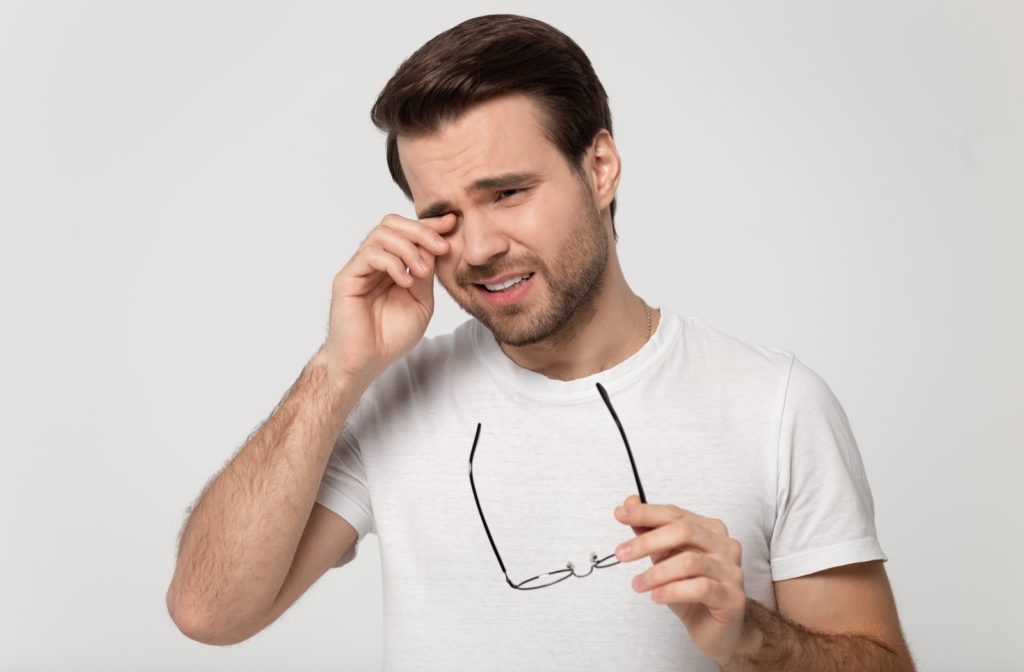Dry eye disease can leave your eyes with a burning, uncomfortable, and irritated feeling. Fortunately, many cases of dry eye are temporary, caused by environmental factors like strong air conditioning in an office, smoky air, or living in a climate with harsh prairie winters and forgetting to turn on your humidifier.
But please, don’t brush off dry eye symptoms as something not concerning. For some people, dry eyes can become a more serious chronic condition and may affect your vision. Your family optometrist can diagnose dry eye disease during a routine eye exam. They can also help you combat dry eye disease before it impacts your vision.
Don’t let dry eye disease become a daily irritation, and certainly don’t wait long enough for it to impact your vision long-term. Learn more about how your eye’s health can impact your vision and look after your symptoms today.
What is Dry Eye Disease?
Dry eye disease is caused by a problem with your tears: the quality of the tears or the quantity. If your tears are evaporating too quickly or you don’t produce enough tears, patches of your eye can become exposed in between blinks.
Dry eye disease has an uncomfortable host of symptoms, including:
- A stinging, burning or scratchy sensation in your eyes
- Production of stringy mucus
- Eye redness
- Discomfort when wearing contact lenses
- Feeling like there’s something in your eye
- Difficulty with nighttime driving
- Light sensitivity
- Excessive eye watering
- Tired eyes
- Blurred vision

What Causes Dry Eye Disease?
Numerous factors can lead to dry eye disease, ranging from internal—medications and health conditions—to external—the environment around you or long periods looking at a screen. Some factors that increase your risk of dry eye disease are:
- Ageing
- Medical conditions such as
- Medications, including
- Antihistamines
- Decongestants
- Hormonal medications
- Antidepressants
- Laser eye surgery
- Blepharitis
- Computer use
- Allergies
- Preservatives in topical eye drops
- Wind, smoke or dry air
- Vitamin A deficiency
Understanding Tears
Tears have a direct effect on dry eye disease and its symptoms. The tears that coat your eye are made up of 3 layers:
- The mucous layer is closest to the eye & keeps the tears in place
- The watery layer is in the center & keeps the eye moist & free of debris
- The lipid layer is the outermost layer that helps keep the tears on the eye & makes blinking smooth
Tears & Your Vision
To understand how our tears can affect our vision, let’s break down the steps that allow us to see:
Light-reflecting off the object we’re viewing enters the front of our eyes, through the transparent surface called the cornea, and into the pupil. That light lands on the retina, where it triggers photoreceptors. It’s then transmitted as electrical impulses via the optic nerve to the brain. Our brains turn those impulses into images, allowing us to see.
Vision is a complex gift! While we’re watching Netflix in our downtime, our bodies are working hard. Interference at any step during this process can lead to vision issues.
Take our tears, for example: properly functioning tears keep the eye’s surface smooth and glossy, like a high-quality camera lens. When the eye isn’t kept moist or the tears break up too quickly in between blinks, dry patches can emerge on the eye’s surface.
Without tears, the surface of the cornea can be rough, uneven, or bumpy. This can distort light as it enters the eye, leading to blurred vision.
Problems Brought on by Dry Eye Disease
At its worst, dry eye can lead to larger problems with the eye and can make contact lens use seem impossible.
Corneal Abrasions
Corneal abrasions are small scratches on the cornea. They can normally heal in the space of a few days, but without addressing the cause (in this case, dry eye) they can remain and lead to further complications.
Eye Infections
Infections in the eye are often painful and uncomfortable. There are 3 categories of eye infections: viral, bacterial, and fungal. Chronic dry eyes can lead to a higher chance of eye infection.
Corneal Ulcers
Corneal ulcers are similar to a sore on the surface of the eye. They are often painful and are considered an ocular emergency. They can be caused by eye infections and corneal abrasions.
Protect Your Vision
While sometimes it may seem as if dry eye disease is just an annoying eye problem that’s not all that serious, it’s never wise to take risks with your vision. Damage that has been done to the eyes can be difficult to reverse, but prevention can make all the difference.
Thankfully, there are a host of management options to deal with dry eye, from prescription eye drops to punctal plugs. Your optometrist can guide you through the right course of action for your eyes.
If you’re struggling with blurred vision, burning eyes, excessive tearing, or other dry eye symptoms, come into Advance Eye Care. Allow our skilled team to assess your eyes and provide you with tools and treatments to manage your dry eye symptoms.



